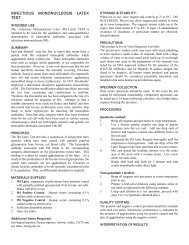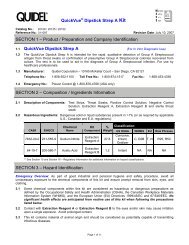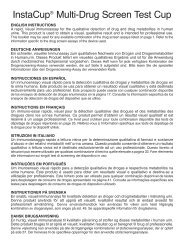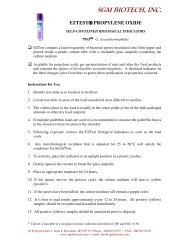english instructions dansk brugsanvisning instruktioner på svenska ...
english instructions dansk brugsanvisning instruktioner på svenska ...
english instructions dansk brugsanvisning instruktioner på svenska ...
Create successful ePaper yourself
Turn your PDF publications into a flip-book with our unique Google optimized e-Paper software.
PRINCIPLE<br />
Each SureStep Drug Screen Test is a one-step immunoassay in which a chemically<br />
labeled drug (drug-protein conjugate) competes with the drug/metabolites that may be<br />
present in urine for limited antibody binding sites. The test device contains a membrane<br />
strip that has been pre-coated with drug-protein conjugate on the test line region.<br />
The colored antibody-colloidal gold conjugate moves along with urine, chromatographically by<br />
capillary action, across the membrane. In the absence of drug/metabolites in the<br />
urine, the colored antibody colloidal gold conjugate attaches to the drug-protein conjugate on<br />
the test region to form a visible colored line as the antibodycomplexes with the drug<br />
protein conjugate. Therefore, the formation of a visible colored line in the test region<br />
occurs when the urine is negative for the drug. When the drug/metabolite is present in<br />
the urine, the drug/metabolite antigen competes with the drug-protein conjugate on the<br />
test region for the limited antibody binding sites. When a sufficient amount of<br />
drug/metabolite is present, it will fill the limited antibody binding sites. This will prevent<br />
attachment of the colored antibody-colloidal gold conjugate to the drug-protein conjugate on<br />
the test region. Therefore, absence of the colored line on the test region indicates a<br />
positive result.<br />
A control line with a different antigen/antibody reaction is also added to the immunochromatographic<br />
membrane strip at the control region to indicate that the test is performed properly. A<br />
colored line should always appear in the control region regardless of the presence of<br />
the drug or metabolites. Therefore, negative urine will produce two colored lines, and<br />
positive urine will produce only one line. The presence of this colored line in the control<br />
region serves as verification that 1) a sufficient volume of urine has been added, and<br />
2) that proper flow was obtained.<br />
STORAGE AND STABILITY<br />
The test device should be stored refrigerated or at room temperature 2-30°C (36-86°F).<br />
Each device should remain in its sealed pouch until use or stated expiration date.<br />
PRECAUTIONS<br />
• FOR IN VITRO DIAGNOSTIC USE.<br />
• For professional use only.<br />
• The pouch containing the device should be sealed. Discard the device if the package<br />
is ripped or torn.<br />
• Avoid cross-contamination of urine samples by using a new specimen collection<br />
container and specimen pipette for each urine sample.<br />
• Urine specimens may be potentially infectious. Proper handling and disposal methods<br />
should be established.<br />
• Do not reuse.<br />
MATERIALS SUPPLIED<br />
• Twenty-five (25) individually wrapped test devices each containing one disposable pipette.<br />
• One instructional booklet.<br />
MATERIALS REQUIRED BUT NOT PROVIDED<br />
• Specimen collection container.<br />
• Timer.<br />
• External positive and negative controls.<br />
SPECIMEN COLLECTION AND HANDLING<br />
The SureStep Drug Screen Tests are designed for use with urine specimens. Fresh<br />
urine does not require any special handling or pretreatment. Urine samples should be<br />
collected such that testing may be performed as soon as possible after the specimen<br />
collection, preferably during the same day. The specimen may be refrigerated at 2-8°C<br />
for 2 days or frozen at -20°C for a longer period of time. Specimens that have been refrigerated<br />
must be equilibrated to room temperature prior to testing. Specimens previously frozen<br />
must be thawed, equilibrated to room temperature, and mixed thoroughly prior to testing.<br />
Note: Urine specimens, and all materials coming in contact with them, should be handled and disposed of<br />
as if capable of transmitting infection. Avoid contact with skin by wearing gloves and proper laboratory attire.<br />
TEST PROCEDURE<br />
Review “Specimen Collection” <strong>instructions</strong>. The test device, patient samples and<br />
controls should be brought to room temperature (20-30°C) prior to testing. Do not open<br />
pouches until ready to perform the assay.<br />
1. Remove the test device from its protective pouch. Label the device with patient or<br />
control identifiction.<br />
2. Using the pipette with each device, draw the urine sample up to marked<br />
line (approximately 0.2 ml) dispense entire contents into the sample well.<br />
Avoid adding drops that contain air since air bubbles in the well may cause<br />
uneven flow or prevent the flow of the sample onto the test strip.<br />
3. Results may appear as early as 5 minutes. Verify positive results at a<br />
read time of 8 minutes. Do not interpret result after 8 minutes.<br />
3








